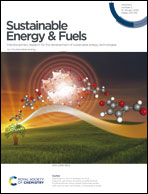Halide-free catalytic carbon dioxide fixation of epoxides to cyclic carbonates under atmospheric pressure†
Abstract
The conversion of epoxides to cyclic carbonates utilizing CO2 is one of the efficient approaches for CO2 fixation. The atmospheric fixation of CO2 generally requires the use of halogen containing catalysts or additionally halogen containing molecules as cocatalysts. However, due to the toxic nature of halogens, the development of halide-free catalysts to synthesize cyclic carbonates from epoxides has gained attention recently. In this work, a water stable aluminium-based polymeric halide free heterogeneous catalyst has been developed to perform epoxide ring expansion to cyclic carbonates using CO2 under atmospheric pressure in the absence of any solvent and cocatalysts. A wide range of epoxides are successfully converted to the corresponding cyclic carbonates in quantitative yield and with high selectivity. The developed catalyst is able to achieve gram scale synthesis of styrene carbonate from styrene oxide under optimized conditions. The material sustained six cycles of catalysis without compromising the catalytic activity and chemical integrity which further confirmed the heterogeneous nature of the catalyst.



 Please wait while we load your content...
Please wait while we load your content...